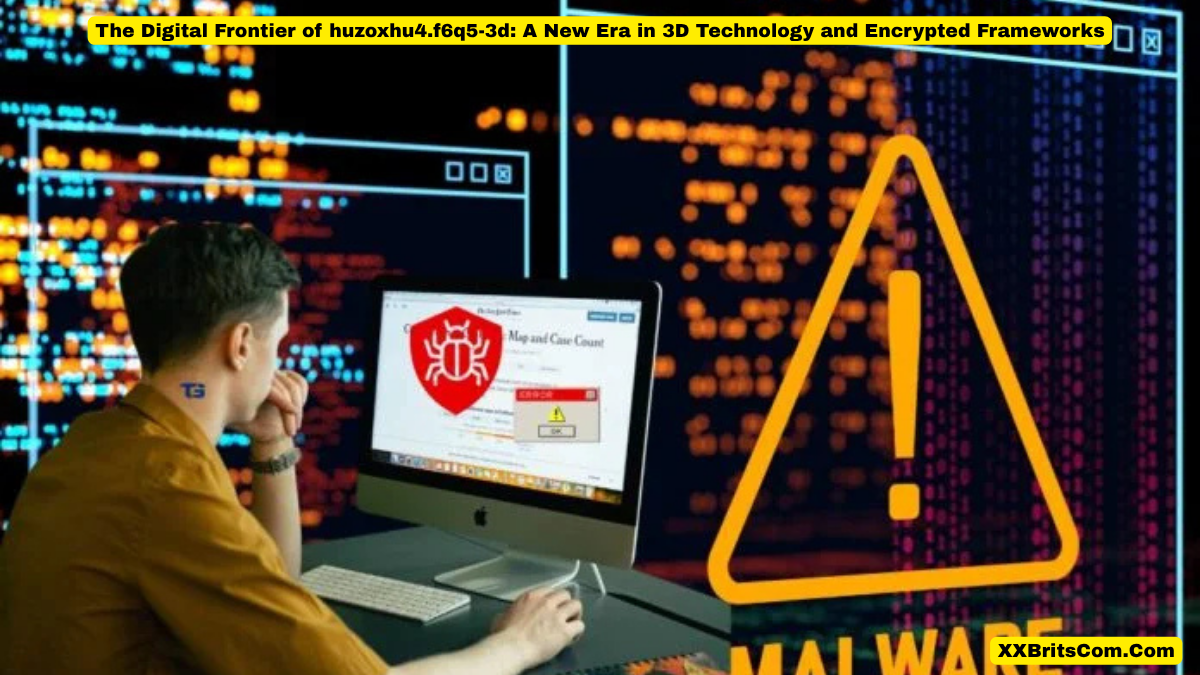Introduction to huzoxhu4.f6q5-3d: What Is It?
The term huzoxhu4.f6q5-3d might look like a random collection of letters and numbers at first glance, but in tech circles, it’s gaining traction as a codename for a next-generation 3D data compression and visualization framework. Think of it as a hybrid between 3D modeling, data encryption, and interactive digital environments. It may sound niche or even fictional, but this concept stands at the intersection of several technological revolutions, from AI-based modeling to secure Web3 environments.
In simpler terms, huzoxhu4.f6q5-3d refers to a multi-dimensional rendering protocol wrapped in a highly encrypted container. It allows developers, designers, and even AI systems to collaborate across platforms in a secure, immersive 3D space.
But where did it originate? It appears to have first emerged in obscure academic papers and cryptographic forums, hinting at a collaborative project between cyber researchers and visual simulation engineers. Now, it’s slowly stepping into the limelight as developers realize its potential.
More than just a string of code, huzoxhu4.f6q5-3d is pushing the boundary of what real-time 3D simulation can achieve in secure environments. It’s not mainstream yet, but it’s certainly making waves where innovation happens first.
The Core Components of huzoxhu4.f6q5-3d Explained
To truly understand the power behind huzoxhu4.f6q5-3d, you have to break down its internal components. It isn’t just about fancy 3D graphics — it involves a deep integration of three major pillars: data structure, encryption, and visual rendering.
First off, the data structure in huzoxhu4.f6q5-3d is remarkably flexible. It uses a modular schema that can adapt based on the type of 3D asset or real-time input being processed. Whether you’re importing CAD models or using dynamic point cloud data from a LiDAR system, it adapts seamlessly.
Then there’s encryption. This isn’t your run-of-the-mill HTTPS stuff. The system operates on a quantum-resistant cryptographic protocol, making it virtually impossible to hijack or manipulate in real time. This is essential for industries like aerospace, defense, and medical imaging, where 3D visual data must remain confidential.
And finally, the visual rendering engine. Built on a custom GPU acceleration pipeline, huzoxhu4.f6q5-3d supports real-time ray tracing and volumetric rendering, making it suitable for simulations, digital twins, and AR/VR applications.
Together, these components offer a solid foundation for a secure, immersive, and highly customizable 3D interaction framework. Whether you’re a tech enthusiast or a developer, it’s clear that huzoxhu4.f6q5-3d isn’t just smoke and mirrors.
Applications of huzoxhu4.f6q5-3d in Modern Industries
What makes huzoxhu4?f6q5-3d exciting isn’t just its structure — it’s how industries are starting to adopt it. From healthcare diagnostics to automotive prototyping, its use cases are expanding fast.
In medical imaging, huzoxhu4.f6q5-3d allows radiologists to render full-body scans in encrypted 3D format. These models can be shared securely with remote experts while maintaining privacy, thanks to their integrated encryption system.
In automotive and aerospace engineering, teams can now collaborate on 3D designs in real-time. Engineers in different parts of the world can co-edit virtual car models, simulate wind tunnel tests, and make precise adjustments — all without leaving the huzoxhu4.f6q5-3d ecosystem.
Even the gaming industry is catching on. Indie developers are using huzoxhu4.f6q5-3d’s rendering capabilities to create hyper-realistic game worlds. Since the engine supports modular plug-ins, game studios can extend its functionality for AI behaviors, physics engines, and more.
These examples only scratch the surface. The real magic lies in its ability to securely process complex visual data — a game-changer for industries that demand speed, accuracy, and confidentiality.
How huzoxhu4.f6q5-3d Enhances Security in Digital Architecture
Security is one of the standout features of huzoxhu4.f6q5-3d. In a world where data leaks and hacks make daily headlines, this technology offers a breath of fresh air.
Unlike traditional 3D systems, which often rely on basic SSL or weak obfuscation, huzoxhu4.f6q5-3d uses a multi-key matrix encryption layer. This means that even if a file is intercepted, it’s mathematically impossible to decrypt it without the correct session keys.
Moreover, the system features role-based access control (RBAC), allowing developers to give team members specific permissions over 3D files. An intern might only be able to view a wireframe, while a lead engineer can manipulate the full-textured model.
Even better? All changes are logged in an immutable ledger — a decentralized blockchain, to be exact. Every action, from rendering to export, is tracked, ensuring full transparency and traceability.
This security framework isn’t just ideal for sensitive data; it’s also great for digital rights management. Artists, designers, and creators can use huzoxhu4.f6q5-3d to publish work while retaining full control over how it’s viewed, copied, or modified.
The Role of AI and Machine Learning in huzoxhu4.f6q5-3d
AI is deeply woven into the fabric of huzoxhu4.f6q5-3d. The platform isn’t just a passive tool — it’s intelligent. It learns from user interactions, optimizes workflows, and can even suggest real-time design changes based on pre-set parameters.
Let’s say you’re rendering a smart city simulation. The AI engine can automatically optimize render settings for performance, apply realistic weather effects, and predict traffic flows using historical data — all in a blink.
Another great example is adaptive compression. 3D files are often huge, especially when they include textures, lighting, and animation. Huzoxhu4.f6q5-3d’s ML algorithms detect redundant data and compress it efficiently without sacrificing visual quality.
In collaborative settings, the AI acts like a virtual assistant. It can detect potential design flaws, recommend material changes, and even predict structural weaknesses in engineering models.
It also learns your habits. If you frequently render scenes with specific lighting, it remembers and pre-configures your environment automatically — saving time and boosting creativity.
Integrating huzoxhu4.f6q5-3d with Existing Tech Stacks
One of the biggest challenges with new technology is compatibility. Nobody wants to reinvent their entire pipeline just to use a new tool. Fortunately, huzoxhu4.f6q5-3d is highly modular and integratable.
It supports major file formats like .fbx, .obj, .gltf, and even DICOM for medical scans. This means you can plug it into Unity, Unreal Engine, or even proprietary engines with minimal hassle.
APIs and SDKs are readily available, enabling developers to embed huzoxhu4.f6q5-3d into web apps, desktop software, or mobile platforms. Its cloud-based deployment also allows it to be part of a CI/CD pipeline, essential for enterprise-grade development.
Furthermore, its compatibility with WebXR and WebGL opens doors for browser-based 3D experiences. You don’t need a powerful PC — just a browser and internet connection to view encrypted 3D assets in real time.
This plug-and-play nature makes it a no-brainer for companies that want security and innovation without disrupting their existing systems.
Challenges and Limitations of huzoxhu4.f6q5-3d
While huzoxhu4.f6q5-3d is a cutting-edge solution, it’s not without its growing pains.
One major issue is the learning curve. The complexity of the system can be overwhelming for new users, especially those unfamiliar with data encryption or 3D workflows. However, detailed documentation and community support are helping bridge that gap.
Another hurdle is hardware compatibility. While it’s optimized for GPU acceleration, older machines might struggle with real-time rendering. Developers must ensure that their systems meet the minimum GPU and RAM requirements.
Lastly, the licensing model is still in flux. Since the technology is relatively new, the cost structures and licensing tiers aren’t standardized yet. For small teams or indie creators, this uncertainty can be a bottleneck.
Despite these limitations, the roadmap for huzoxhu4.f6q5-3d looks promising. Developers are actively working on updates to improve efficiency, usability, and scalability.
FAQs About huzoxhu4.f6q5-3d
Q1: Is huzoxhu4.f6q5-3d open-source or commercial?
As of now, huzoxhu4.f6q5-3d operates under a dual-license model. Core components are open-source, but advanced features (like quantum encryption and enterprise rendering tools) require a commercial license.
Q2: What industries benefit the most from huzoxhu4.f6q5-3d?
Primarily, industries dealing with sensitive 3D data — healthcare, defense, architecture, automotive, and AR/VR development — benefit the most due to its secure and scalable design.
Q3: Can huzoxhu4.f6q5-3d run on mobile devices?
Yes, but with limitations. The platform offers a lightweight mobile viewer module that supports encrypted viewing, but full-scale rendering is typically reserved for desktop or cloud environments.
Q4: Does it require internet access to function?
For basic operations, it can run offline. However, collaborative features, blockchain tracking, and real-time updates require internet access and sometimes a connected cloud server.
Q5: How steep is the learning curve for beginners?
Moderate to steep. It’s not a plug-and-play solution like SketchUp. However, with tutorials and practice, users can quickly unlock its true potential.
Conclusion: Is huzoxhu4.f6q5-3d the Future of 3D Encryption and Collaboration?
There’s no denying that huzoxhu4.f6q5-3d is an ambitious, futuristic framework. It merges security, AI, and 3D rendering into a single, powerful ecosystem — something few tools attempt, let alone master.
While it’s still maturing, early adopters are already seeing massive gains in productivity, data security, and rendering quality. For teams that demand precision and privacy in a 3D world, huzoxhu4.f6q5-3d is more than a trend — it’s a revolution in the making.




